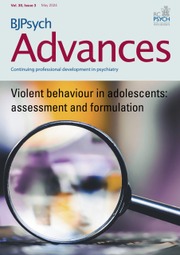Post-traumatic stress disorder (PTSD) is a common consequence of trauma exposure that can profoundly disrupt life. The PTSD diagnosis has repeatedly expanded over time; ICD-11's approach has been to differentiate ‘PTSD’ and ‘complex PTSD’ ‘sibling’ diagnoses. PTSD is complex to diagnose. For example, many of the DSM-5-TR and ICD-11 diagnostic criteria for PTSDs are not trauma-related and almost all PTSD symptoms are transdiagnostic (i.e. common to several mental health problems/diagnoses) (Siddaway Reference Siddaway2024). Of all aspects of PTSD, ‘flashbacks’ are perhaps the most amorphous and widely misunderstood.
Definition in the DSM and ICD
Flashbacks have been defined differently over time and continue to mean different things to different people, causing widespread misunderstanding and miscommunication, and presumably impacting appropriate treatment planning. Clinicians and patients both use the word ‘flashbacks’ to describe a wide variety of cognitive phenomena related to distressing or traumatic past experiences.
The general absence of an official definition of flashbacks to date has created uncertainty about whether this term should be reserved for extreme episodes or broadened to include all intrusive memories that are accompanied by a sense of reliving an event in the present, even if only fleeting (Brewin Reference Brewin, Dalgleish and Joseph2015). DSM-5-TR and ICD-11 have opted for the latter approach: assigning flashbacks an inclusive, overarching meaning that is synonymous with reliving/re-experiencing when awake – thereby rendering ‘reliving,’ ‘re-experiencing’ and ‘flashbacks’ interchangeable synonyms. Flashbacks are understood in DSM-5-TR and ICD-11 as existing on a continuum that ranges from fleeting (a transient sense of traumatic experience(s) reoccurring in the present) to extreme (total disconnection from the current autobiographical self and one's present surroundings for minutes or longer). Thus, at present, the flashback nomenclature encapsulates intrusive trauma memories even though flashbacks and intrusive memories are included as separate diagnostic symptoms/criteria in DSM-5-TR and ICD-11 PTSDs.
Differential diagnosis
Flashbacks are the only symptom unique to PTSDs (Siddaway Reference Siddaway2024). They involve vivid, decontextualised, highly distressing multisensory/perceptual material (usually images, but commonly also sounds, smells, tastes, bodily sensations, actions and thoughts) repeatedly entering awareness involuntarily, creating a sense that past threatening and horrific experiences are not just remembered but experienced as repeatedly occurring again in the present (Hackmann Reference Hackmann, Ehlers and Speckens2004; Brewin Reference Brewin2010). Flashbacks are involuntarily triggered by internal and external reminders that relate in some way to traumatic experiences (Hackmann Reference Hackmann, Ehlers and Speckens2004; Brewin Reference Brewin2010).
A careful consideration of the nature of flashbacks helps distinguish them from other psychological processes and phenomena that are commonly mistaken for flashbacks, including:
• involuntary thoughts, images and memories: positive, negative and neutral material regularly spontaneously enters everyone's minds without causing clinically significant distress or functional impairment;
• repetitive intrusive (distressing) thoughts, images and memories (Brewin Reference Brewin2010) and repetitive nightmares (Sheaves Reference Sheaves, Rek and Freeman2023), which characterise several psychological/psychiatric disorders; although these often induce bodily reactions and feelings associated with the original experience(s), individuals remain aware of the here and now and that they are recalling a memory;
• ‘thinking about’ (retrieving episodic memories of) traumatic experience(s) in the absence of other PTSD symptoms, either when voluntarily/deliberately thinking about past events or only when reminded;
• trauma-related preoccupation, worry or rumination: these often take the form of regretting what the person did or did not do, thoughts of how bad life is or could have been because of one or more traumatic experiences, wishing experiences had not happened and wondering why an experience happened to them.
The dual representation theory of PTSD
Several cognitive models describe the development and maintenance of PTSDs (see Siddaway Reference Siddaway2024). The most detailed theoretical account of flashbacks and their underlying neural mechanisms is provided by the dual representation theory of PTSD (Brewin Reference Brewin, Gregory and Lipton1996, Reference Brewin2010). According to this theory, flashbacks arise if, during extreme stress and horror, an individual's brain prioritised encoding survival-related perceptual information and action over higher-order cognitive activity. Consequently, multisensory information is not encoded with enough contextual information, with the result that it can only be recalled involuntarily when automatically triggered by trauma reminders. This leads to the brain responding as though past experiences are happening again in the present, producing intense reliving, with associated emotional and physiological reactions.
The dual representation theory proposes that flashbacks initially reflect an adaptive response that is part of a natural adjustment process following trauma: re-presenting information for more detailed processing when the danger has passed. ‘Processing’ traumatic experiences (with or without professional support) entails deliberately bringing distressing, intrusive multisensory/perceptual information about traumatic experiences to mind and holding this in conscious attention, allowing perceptual information to be re-encoded into episodic memory, where it can be made verbally accessible and assigned a temporal and spatial context. Once provided with this context, trauma reminders (sensory cues) no longer signal a current source of danger, and as a result flashbacks become progressively weaker and less frequent. Now, when trauma reminders are encountered or the person chooses to think about event(s), coherent, contextualised, less distressing memories, which are experienced as belonging to the past, are retrieved.
Diagnosis in practice
Flashbacks, and PTSD more broadly, are complex to assess, understand and diagnose. Readers are directed to Siddaway (Reference Siddaway2024) for detailed guidance on identifying, assessing, understanding and diagnosing PTSDs.
Data availability
Data availability is not applicable to this article as no new data were created or analysed in this study.
Funding
This research received no specific grant from any funding agency, commercial or not-for-profit sectors.
Declaration of interest
None.




eLetters
No eLetters have been published for this article.